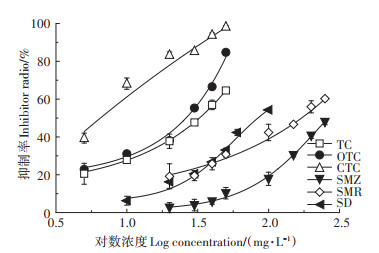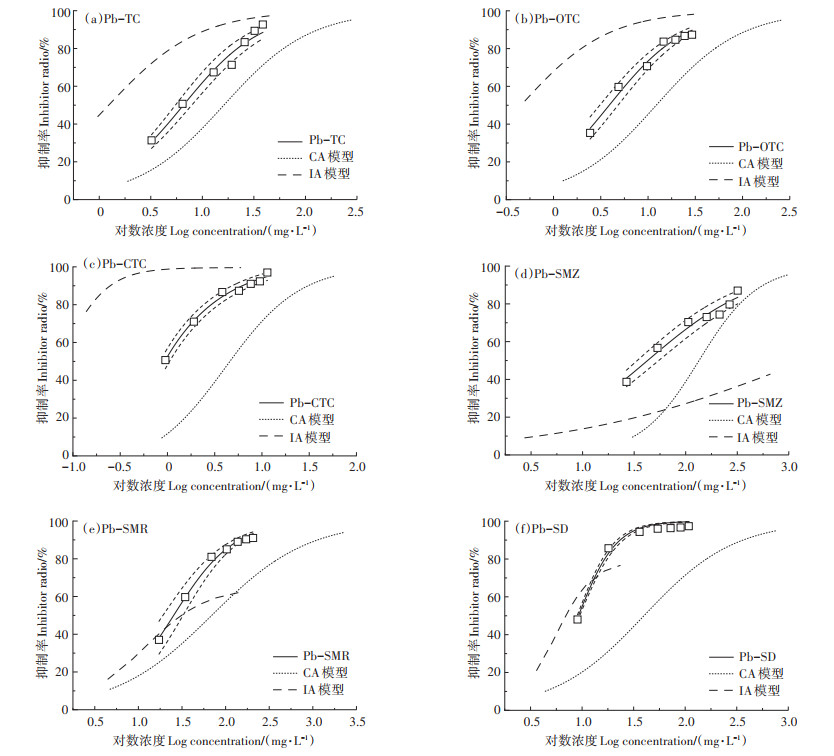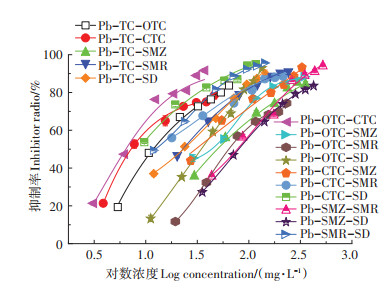重金属污染已经成为全球性的环境问题[1-2],一旦进入食物链会直接影响人体健康[3],美国环保署(USEPA)已将Pb、Cd等列为水环境中优先控制污染物[4]。按照我国《地表水环境质量标准》(GB 3838—2002)Ⅲ类水体要求,Pb浓度应小于0.05 mg·L-1,调查表明约50%的地表水达不到水质Ⅲ类标准[5]。何佳等[6]检测的黄河水体中Pb浓度最高达0.165 mg· L-1,Qiao等[7]在长江南京段检测的Pb浓度为0.065~0.107 mg·L-1,均远超出水质Ⅲ类标准。Zhang等[8]在美国密西西比河水体中检出Pb浓度为5.2~6.85 μg· L-1。由此可知,重金属Pb已经成为国内外地表水中常见的污染物之一。
同时,我国抗生素使用量全球最大[9],而绝大部分抗生素被生物体的吸收率仅为10%~40%,大部分以各种形式排出体外,并对水体造成污染。作为一种新型污染物,抗生素在水环境中的检出率超过60%[10]。Chen等[11]在长江三角洲地表水中检出磺胺类抗生素浓度达581.8 ng·L-1,四环素类抗生素达97.4 ng·L-1;Liang等[12]在珠江检出磺胺类和四环素类抗生素浓度最高为273.6 ng·L-1和13.1 ng·L-1。Proia等[13]、Kim等[14]在西班牙和美国地表水体中分别检测出磺胺甲恶唑和四环素类抗生素的浓度为213.7~907.6 ng·L-1和20.0~1 210.0 ng·L-1。现有研究表明,磺胺类、四环素类抗生素在水体中的检出较高[15-16],对水环境造成了严重的生态风险,重金属与抗生素对生态环境及人类健康构成的威胁已不容忽视。
近年来生物毒性监测已成为评价水环境污染程度的重要手段[17-23]。发光菌作为受试生物,尤其是费氏弧菌对污染物敏感、反应速度快,在重金属、抗生素等水质急性毒性评价中得到广泛应用[24]。1981年Bulich等[25]首先采用发光菌(Photobacterium phosphoreum)对废水进行了毒性检测和评价,并逐渐发展为ISO标准的Microtox检验方法[26];马梅等[27]研究了Pb、Cd等对淡水发光菌(Vibrio qinghaiensis sp.-Q67)的生物毒性;汪皓琦等[28-29]、方政等[30]、魏东斌等[31]则研究了抗生素对发光菌的急性毒性。
1939年Bliss[32]首次研究了混合物联合毒性,1965年Sprague等[33]第一次提出并定义了毒性单位(Toxic unit,TU),已经成为判别联合毒性的主要依据。现有文献研究表明,混合物产生的毒性并非混合物中单一物质的毒性加和[34]。在假定各组分之间不存在相互作用的前提下,浓度相加模型(Concentration addition model,CA)和独立作用模型(Independent action model,IA)被广泛用于混合物的联合毒性评价[35-36]。CA模型又称为剂量加和模型,各化合物的综合效应可以相加,用于评价具有相同或相似作用机制的化学物质混合物的毒性[37];IA模型也称为效应加和模型,各化合物的综合效应不可相加,适用于具有相异作用机制的化学物质的混合毒性评价[32]。近年来,CA和IA模型在定量毒性研究中得到广泛的应用[38-42]。研究发现CA模型所预测毒性普遍高出IA模型数倍[38-41],使用CA模型预测可能会高估环境风险;但是从风险评估的角度考虑,CA模型可能更加安全实用,欧美国家通常采用CA模型进行风险评估[42]。
本文以水环境检出率较高的重金属Pb、四环素类和磺胺类抗生素为研究对象,开展重金属与抗生素复合污染的急性毒性研究,系统评估重金属和抗生素复合污染的急性毒性,可为全面评价水环境重金属和抗生素复合污染的潜在风险提供基础数据。
1 材料与方法 1.1 试剂与仪器硝酸铅[Pb(NO3)2]、氯化钠(NaCl)、二甲基亚砜(Dimethyl sulfoxide,DMSO),购于国药化学试剂有限公司;四环素(Tetracycline,TC)、氧四环素(Oxytetracycline,OTC)、氯四环素(Chlorotetracycline,CTC)、磺胺二甲基嘧啶(Sulfamethazine,SMZ)、磺胺甲基嘧啶(Sulfamethine,SMR)和磺胺嘧啶(Sulfadiazine,SD),购于上海阿拉丁生化科技有限公司;所用试剂均为分析纯。费氏弧菌(Vibrio fischeri)及便携式急性毒性检测仪(Dleta Tox ®Ⅱ),购于美国Modern Water公司。
使用的重金属和抗生素均在1%(V/V)DMSO的帮助下溶解,然后用3%(m/V)NaCl溶液稀释,得到10 mg·L-1的Pb2+储备液、500 mg·L-1的四环素类抗生素储备液和250 mg·L-1的磺胺类抗生素储备液。试验时,用3%(m/V)NaCl溶液稀释成不同浓度梯度。为尽量保证各污染物浓度覆盖10%~90%的相对发光强度,各溶液浓度范围为Pb2+:0.01~5 mg·L-1,TC、CTC、OTC:5~50 mg·L-1,SD:10~100 mg·L-1,SMZ、SMR:20~250 mg·L-1[43-44]。最终测试前,各溶液中DMSO的含量不高于0.1%(V/V),此时DMSO对发光菌的影响可忽略不计[45]。
1.2 急性毒性试验过程急性毒性试验按照《食品安全国家标准急性经口毒性试验》(GB 15193.3—2014)和《水质、水样对弧菌类光发射抑制影响的测定(发光细菌试验)第3部分:使用冻干细菌法》(ISO 11348-3—2007)进行[46]。试验前,先将发光菌冻干粉与1 mL 2%(m/V)的NaCl溶液充分混合制成水合试剂,置于20 ℃室温中活化15 min,菌液在3 h内使用。
1.2.1 单一急性毒性测试将100 μL细菌悬浮液注入900 μL一系列浓度梯度样品中。使用900 μL 3%(m/V)NaCl和100 μL 0.1%(V/V)DMSO溶液作为阳性对照。暴露15 min后通过Delta Tox毒性仪检测费氏弧菌发光抑制率,并计算半数效应浓度(EC50),每个浓度设置3个平行[47]。
1.2.2 联合毒性测试试验中,Pb和抗生素等毒性比例混合[19, 48-49],共设计7个浓度梯度(相应EC50值的0.2、0.4、0.6、0.8、1.0、1.2、1.4倍),以测定Pb和抗生素的混合物毒性。
试验使用毒性单位(Toxic unit,TU)法[50],其计算方法如公式(1)所示。

|
(1) |
式中:CXi为污染物X对发光菌的相对发光强度为50时的浓度,mg·L-1;EC50Xi为污染物X的EC50值,mg· L-1。当TU < 0.8时,毒物之间为协同作用;当0.8 < TU < 1.2时,毒物之间为简单的相加作用;当TU>1.2时,毒物之间为拮抗作用[51]。
1.2.3 联合毒性模型预测鉴于Pb和抗生素的毒性作用模式仍不清楚,为了更好地了解污染物之间的作用模式,本文假定污染物之间无相互作用,使用浓度相加模型(CA)与独立作用模型(IA)来辅助分析污染物之间的联合作用模式,并采用95%置信区间表征混合物的浓度-剂量效应曲线(CRCs),以减少分析过程中的偶然误差而导致对联合作用的误判。
浓度相加模型(CA)适用于评价各组分对受试生物具有相似毒性作用方式的混合体系联合毒性,其定义式为[52]:

|
(2) |
式中:ECx,mix为混合物导致x%抑制率时的浓度,mg· L-1;ECx,i是第i种组分导致x%抑制率的浓度,mg·L-1;pi表示第i种组分在混合物中所占的浓度分数。
独立作用模型(IA)适用于评价各组分对受试生物具有不同毒性作用模式的联合毒性作用,其定义式为[52]:

|
(3) |
式中:Emix表示预测的效应范围;ECx,i是第i种组分导致x%抑制率时的浓度,mg·L-1;pi表示第i种组分在混合物中所占的浓度分数;fi表示第i种组分对发光菌的浓度-剂量效应曲线方程[30]。
将模型预测得到的EC50值与试验得到的EC50值进行对比,比值记为相对百分比差异(Relative percent difference,RPD),可以通过RPD值来表征毒性预测模拟曲线的偏离程度。RPD值由公式(4)计算。

|
(4) |
式中:EC50,model为预测模型拟合所得值,mg·L-1;EC50为试验所得值,mg·L-1。
1.2.4 统计分析方法通过Origin 9.0软件以Logistic为模型进行拟合,得到浓度-剂量效应曲线(Concentration - response curve,CRC),如公式(5)所示[18]:

|
(5) |
式中:y为发光抑制率,%;x为污染物以10为底数的对数浓度,mg·L-1。p和log x0为方程的两个常数。当y取50时,x的值即为EC50值。通过相关系数(R2)来描述方程拟合的相关性。
2 结果与讨论 2.1 重金属Pb的毒性效应重金属Pb对费氏弧菌的浓度-剂量效应曲线如图 1所示,拟合的相关参数如表 1所示。由图 1和表 1可知,浓度-剂量效应曲线的线性相关系数R2值大于0.99,表明重金属Pb的浓度与其对费氏弧菌的发光抑制率有着良好的相关性。徐恒蒲等[53]也通过明亮发光杆菌T3(Photobacterium phosphoreum T3)对Pb污染土壤浸提液的生物毒性进行了测定,表明污染土壤的生物毒性与Pb含量表现出正相关性。

|
图 1 重金属Pb对费氏弧菌的浓度-剂量效应曲线 Figure 1 The fitted concentration-response curve of the single toxicity of heavy metal to Vibrio fischeri |
|
|
表 1 浓度-剂量效应曲线的拟合参数 Table 1 The fitted parameters of the CRCs of heavy metal |
6种抗生素对费氏弧菌的浓度-剂量效应曲线如图 2所示,拟合的相关参数如表 2所示。由图 2和表 2可知,浓度-剂量效应曲线R2值均大于0.91,表明6种抗生素的浓度与其对费氏弧菌的发光抑制率正相关。P值范围从0.799到1.498,表明费氏弧菌对6种抗生素的敏感程度不同。而EC50可以反映污染物毒性大小,EC50越小,其毒性越大。根据表 2的EC50值,6种抗生素对费氏弧菌的毒性依次为CTC(6.52 mg·L-1)> OTC(21.40 mg·L-1)>TC(29.19 mg·L-1)>SD(87.38 mg· L-1)>SMR(169.56 mg·L-1)>SMZ(263.74 mg·L-1)。

|
图 2 6种抗生素对费氏弧菌的浓度-剂量效应曲线 Figure 2 The fitted concentration-response curves of the single toxicity of six antibiotics to Vibrio fischeri |
|
|
表 2 浓度-剂量效应曲线的拟合参数 Table 2 Fitting parameter values of concentration-dose effect curve |
宋雪薇等[54]研究了磺胺类抗生素和四环素类抗生素对大肠杆菌的生物毒性,结果表明四环素类抗生素的EC50值比磺胺类抗生素低一个数量级,意味着四环素类抗生素的毒性更强。González-Pleiter等[55]和Wollenberger等[56]也发现四环素类抗生素对小球藻和大型水蛭的毒性均比磺胺类抗生素强。本研究的结果表明,四环素类抗生素的毒性远高于磺胺类抗生素,与上述研究的结论一致。这种现象可能是由于发光菌与四环素类和磺胺类抗生素相互作用的机理不同。Deng等[57]的研究表明磺胺类抗生素会影响费氏弧菌发光强度的受体蛋白,即LuxR蛋白。而四环素类抗生素是通过阻断氨基酸和tRNA的结合来抑制与费氏弧菌相关蛋白质的合成,进而影响发光强度[58]。
2.3 Pb-抗生素二元混合物的联合毒性效应 2.3.1 二元混合物联合毒性Pb-抗生素二元混合物的浓度-剂量效应曲线如图 3所示,拟合的相关参数如表 3所示。由图 3和表 3可知,拟合曲线的R2值均大于0.96,表明Pb-抗生素二元混合物的浓度与其对费氏弧菌的发光抑制率相关。将混合物的EC50值与各组分的EC50值之和进行比较,发现混合物的EC50值显著低于其加和值,表明混合物组分之间可能存在协同效应。Pb-抗生素二元混合物的TU值均小于0.8,也表明两者之间具有协同效应,重金属Pb与6种抗生素的二元混合物的协同作用依次为Pb-CTC>Pb-SD>Pb-SMR>Pb-OTC> Pb-SMZ>Pb-TC,与Broderius等[51]的研究相符合。尽管四环素单一存在时对费氏弧菌呈现出更强的毒性,但是自然环境中多以混合污染物的形式出现,其联合毒性可能会随着存在方式的差异导致复合作用效应的不同。

|
图 3 Pb-抗生素二元混合物对费氏弧菌的浓度-剂量效应曲线 Figure 3 The fitted concentration-response curves of the joint toxicity of binary mixtures of Pb-antibiotics to Vibrio fischeri |
|
|
表 3 Pb-抗生素二元混合物的联合毒性及联合作用 Table 3 The observed joint toxicity and combined effect mode of binary mixtures of Pb-antibiotics |
Pb-抗生素二元混合物的CA和IA模型预测曲线如图 4所示,拟合的相关参数如表 4所示。由图 4和表 4可知,Pb-抗生素的IA曲线偏离二元混合物的浓度-剂量效应曲线较大,而CA模型预测趋势与二元混合物浓度-效应曲线相似,且预测结果覆盖实际测试的全部对数浓度及抑制率,表明相较于IA模型,CA模型预测Pb-抗生素二元混合物联合效应的准确率更高。Deneer[59]评估了202个农药混合物,证实CA模型对混合物的联合毒性预测更为准确。Faust等[60]也发现CA模型更适合对混合物的毒性进行预测。

|
空心方块为试验数据点,虚线代表置信区间。下同 Hollow squares represent experimental data, dotted line represent confidence interval. The same below 图 4 Pb-抗生素二元混合物的浓度-剂量效应曲线和CA、IA模型预测曲线 Figure 4 The concentration-response curves of the binary mixtures of Pb-antibiotics and the predicted joint toxicity by the CA and IA model |
|
|
表 4 Pb-抗生素二元混合物CA模型和IA模型预测的EC50值及RPD值 Table 4 The predicted EC50 values of binary of Pb and antibiotics by the CA and IA models and the corresponding RPD values of the model curves and the CRCs |
本文6种Pb-抗生素二元混合物的浓度-剂量效应曲线均位于CA曲线的左上方,表明二元混合物联合毒性存在协同作用,与CA曲线模型相符,也与表 3计算的TU值规律一致。进一步分析RPD-CA可知,Pb-SMZ、Pb-SMR、Pb-SD的RPD-CA大于Pb-TC、Pb-OTC和Pb-CTC,表明Pb与四环素类抗生素之间的协同作用小于Pb与磺胺类抗生素,意味着Pb与四环素类抗生素的联合毒性小于Pb与磺胺类抗生素的联合毒性。
2.4 Pb-抗生素三元混合物的联合毒性效应 2.4.1 三元混合物联合毒性Pb-抗生素三元混合物的浓度-剂量效应曲线如图 5所示,拟合的相关参数如表 5所示。由图 5和表 5可知,浓度-剂量效应曲线的R2值均大于0.97,表明Pb-抗生素三元混合物的浓度与发光菌发光强度的抑制率存在线性关系。Pb-OTC-SD的TU值大于0.8、小于1.2,表明三者之间具有相加效应;其余Pb-抗生素三元混合物TU值均小于0.8,表明三者之间具有协同效应,与Broderius等[51]的研究规律一致。

|
图 5 Pb-抗生素三元混合物对费氏弧菌的浓度-剂量效应曲线 Figure 5 The fitted concentration-response curves of the joint toxicity of ternary mixtures of Pb-antibiotics to Vibrio fischeri |
|
|
表 5 Pb-抗生素三元混合物的联合毒性及联合作用 Table 5 The observed joint toxicity and combined effect mode of ternary mixtures of Pb-antibiotics |
Pb-OTC-SD表现为相加作用,推测可能是OTC与SD毒性大小在同一数量级,等毒性比例混合时浓度相差不大。同时由单一毒性测试可知,费氏弧菌对OTC的敏感程度在3种四环素类抗生素中最弱,SD又与Pb的协同作用最强,故而SD抑制了OTC的部分毒性,导致在Pb-OTC-SD联合作用时表现出简单相加作用。
2.4.2 三元混合物联合毒性的CA和IA模型预测Pb-抗生素三元混合物的CA和IA模型预测曲线如图 6所示,拟合的相关参数如表 6所示。

|
图 6 Pb-抗生素三元混合物的浓度-剂量效应曲线和CA、IA模型预测曲线 Figure 6 The concentration-response curves of the ternary mixtures of Pb-antibiotics and the predicted joint toxicity by the CA and IA model |
|
|
表 6 Pb-抗生素三元混合物CA模型和IA模型预测的EC50值及RPD值 Table 6 The predicted EC50 values of ternary of Pb and antibiotics by the CA and IA models and the corresponding RPD values of the model curves and the CRCs |
由图 6和表 6可知,CA模型可以预测Pb-抗生素三元混合物的联合毒性,预测趋势与三元混合物浓度-效应曲线更为吻合,且预测结果能够覆盖实际测试的全部对数浓度及抑制率。而IA模型能更好地预测Pb - TC - SD、Pb - OTC -CTC、Pb - CTC - SMR、Pb - CTC-SD、Pb-SMR-SD的联合毒性,可能是受到混合物中的组分数少的影响,Villa等[61]的研究中也曾出现过类似现象。此外,本文所测试的15种三元混合物的浓度-剂量效应曲线均位于CA曲线的上方,表明三元混合物之间存在着协同或相加作用,与CA曲线模型相符,也与表 5所计算的TU值一致。
3 结论本文以费氏弧菌为受试生物,探究了重金属Pb和6种抗生素的单一急性毒性与联合毒性,并利用CA模型和IA模型进行了联合毒性的预测,结果表明:
(1)单一抗生素对费氏弧菌的毒性依次为CTC(6.52 mg·L-1)>OTC(21.40 mg·L-1)>TC(29.19 mg·L-1)> SD(87.38 mg·L-1)>SMR(169.56 mg·L-1)>SMZ(263.74 mg·L-1)。由于四环素类抗生素对费氏弧菌的毒性均大于磺胺类抗生素,可推断费氏弧菌对于四环素类抗生素更为敏感。
(2)重金属Pb和四环素类抗生素、磺胺类抗生素共存时,混合物的毒性急剧上升;其中Pb-抗生素二元混合物的TU值均小于0.8,表明两者之间具有协同效应;而除Pb-OTC-SD外其余Pb-抗生素三元混合物TU值均小于0.8,表明三者之间具有协同效应;PbOTC-SD的TU值大于0.8、小于1.2,表明三者之间具有相加效应。
(3)CA模型相对于IA模型偏离浓度-剂量效应曲线更小,能更好地预测重金属Pb和四环素类抗生素、磺胺类抗生素混合物体系的联合毒性,CA模型也更加实用。
(4)由6种抗生素对费氏弧菌的EC50可知,磺胺类的毒性弱于四环素类,但Pb与磺胺类抗生素的协同作用大于Pb与四环素类抗生素。所以在Pb与抗生素共存的自然水环境中,磺胺类抗生素的生态风险可能会超过四环素的生态风险,值得关注。
| [1] |
朱爱萍, 陈建耀, 江涛, 等. 北江流域横石河-翁江沿岸土壤重金属污染特征分析[J]. 中国环境科学, 2015, 35(2): 506-515. ZHU Ai-ping, CHEN Jian-yao, JIANG Tao, et al. Characteristics analysis of heavy metal pollution in soil alongside Hengshihe and Wengjiang River in Beijiang Basin[J]. China Environmental Science, 2015, 35(2): 506-515. |
| [2] |
王玉军, 吴同亮, 周东美, 等. 农田土壤重金属污染评价研究进展[J]. 农业环境科学学报, 2017, 36(12): 2365-2378. WANG Yu-jun, WU Tong-liang, ZHOU Dong-mei, et al. Advances in soil heavy metal pollution evaluation based on bibliometrics analysis[J]. Journal of Agro-Environment Science, 2017, 36(12): 2365-2378. |
| [3] |
USEPA. Toxic and priority pollutants under the Clean Water Act: EPA 40 CFR Part 423, Appendix A[R/OL].(2014-01-19)[2020-03-02]. https://www.epa.gov/eg/toxic-and-priority-pollutants-under-cleanwater-act.
|
| [4] |
黄益宗, 郝晓伟, 雷鸣, 等. 重金属污染土壤修复技术及其修复实践[J]. 农业环境科学学报, 2013, 32(3): 409-417. HUANG Yi-zong, HAO Xiao-wei, LEI Ming, et al. The remediation technology and remediation practice of heavy metals-contaminated soil[J]. Journal of Agro-Environment Science, 2013, 32(3): 409-417. |
| [5] |
Li P Y, Qian H, Howard K W F, et al. Heavy metal contamination of Yellow River alluvial sediments, northwest China[J]. Environmental Earth Sciences, 2015, 73(7): 3403-3415. DOI:10.1007/s12665-014-3628-4 |
| [6] |
何佳, 时迪, 王贝贝, 等. 10种典型重金属在八大流域的生态风险及水质标准评价[J]. 中国环境科学, 2019, 39(7): 2970-2982. HE Jia, SHI Di, WANG Bei-bei, et al. Ecological risk assessment and water quality standard evaluation of 10 typical metals in eight basins in China[J]. China Environmental Science, 2019, 39(7): 2970-2982. |
| [7] |
Qiao S Q, Yang Z S, Pan Y J, et al. Metals in suspended sediments from the Changjiang(Yangtze River)and Huanghe(Yellow River)to the sea, and their comparison[J]. Estuarine Coastal & Shelf Science, 2007, 74(3): 539-548. |
| [8] |
Zhang Z Q, Wang J J, Ali A, et al. Heavy metal distribution and water quality characterization of water bodies in Louisiana's Lake Pontchartrain Basin, USA[J]. Environmental Monitoring and Assessment, 2016, 188(11): 628. DOI:10.1007/s10661-016-5639-y |
| [9] |
Jin H Y, Kyoung W K, Kim S D. Effect of hardness on acute toxicity of metal mixtures using Daphnia magna:Prediction of acid mine drainage toxicity[J]. Journal of Hazardous Materials, 2006, B138: 16-21. |
| [10] |
王丹, 隋倩, 赵文涛, 等. 中国地表水环境中药物和个人护理品的研究进展[J]. 科学通报, 2014, 59(9): 743-751. WANG Dan, SUI Qian, ZHAO Wen-tao, et al. Pharmaceutical and personal care products in the surface water of China:A review[J]. Chinese Science Bulletin, 2014, 59(9): 743-751. |
| [11] |
Chen K, Zhou J L. Occurrence and behavior of antibiotics in water and sediments from the Huangpu River, Shanghai, China[J]. Chemosphere, 2014, 95: 604-612. DOI:10.1016/j.chemosphere.2013.09.119 |
| [12] |
Liang X M, Chen B W, Nie X P, et al. The distribution and partitioning of common antibiotics in water and sediment of the Pearl River Estuary, South China[J]. Chemosphere, 2013, 92(11): 1410-1416. DOI:10.1016/j.chemosphere.2013.03.044 |
| [13] |
Proia L, Lupini G, Osorio V, et al. Response of biofilm bacterial communities to antibiotic pollutants in a Mediterranean river[J]. Chemosphere, 2013, 92(9): 1126-1135. DOI:10.1016/j.chemosphere.2013.01.063 |
| [14] |
Kim S C, Carlson K. Temporal and spatial trends in the occurrence of human and veterinary antibiotics in aqueous and river sediment matrices[J]. Environmental Science & Technology, 2007, 41(1): 50-57. |
| [15] |
吴青峰, 洪汉烈. 环境中抗生素污染物的研究进展[J]. 安全与环境工程, 2010, 17(2): 68-72. WU Qing-feng, HONG Han-lie. Progress of research on antibiotic contamination[J]. Safety and Environmental Engineering, 2010, 17(2): 68-72. |
| [16] |
傅海霞, 刘怡, 董志英, 等. 抗生素与重金属复合污染的生态毒理效应研究进展[J]. 环境工程, 2016, 34(4): 60-63, 104. FU Hai-xia, LIU Yi, DONG Zhi-ying, et al. Progress in research on ecological toxicity of combined pollution of antibiotics and heavy metals[J]. Environmental Engineering, 2016, 34(4): 60-63, 104. |
| [17] |
赵莉, 杨虹, 郭晶晶. 二元含汞重金属混合物对费氏弧菌的联合毒性研究[J]. 安全与环境学报, 2015, 15(1): 297-300. ZHAO Li, YANG Hong, GUO Jing-jing. Study on the combined toxicity of binary heavy metal mixture to Vibrio fischeri[J]. Journal of Safety and Environment, 2015, 15(1): 297-300. |
| [18] |
Ding K K, Lu L P, Wang J Y, et al. In vitro and in silico investigations of the binary-mixture toxicity of phthalate esters and cadmium(Ⅱ)to Vibrio qinghaiensis sp.-Q67[J]. Science of the Total Environment, 2017, 580: 1078-1084. DOI:10.1016/j.scitotenv.2016.12.062 |
| [19] |
Borecka M, Białk-Bielińska A, Haliński Ł P, et al. The influence of salinity on the toxicity of selected sulfonamides and trimethoprim towards the green algae Chlorella vulgaris[J]. Journal of Hazardous Materials, 2016, 308: 179-186. DOI:10.1016/j.jhazmat.2016.01.041 |
| [20] |
USEPA. EPA-822-R-03-028, Draft update of ambient water quality criteria for copper[S]. Washington D C: USEPA, 2003.
|
| [21] |
Galiulin R V, Bashkin N, Galiulina R A. Ecological risk assessment of riverine contamination in the Caspian Sea Basin:A conceptual model for persistent organochlorina ted compounds[J]. Water Air and Soil Pollution, 2005, 163: 33-51. DOI:10.1007/s11270-005-8134-6 |
| [22] |
Asagba S O, Obi F O. A comparative evaluation of the biological effects of environmental cadmium-contaminated control diet and laboratory-cadmium supplemented test diet[J]. BioMetals, 2005, 18: 155-161. DOI:10.1007/s10534-004-4257-2 |
| [23] |
Gill U, Chu I, Ryan J J, et al. Polybrominated diphenyl ethers:Human tissue levels and toxicology[J]. Reviews of Environment Contamination and Toxicology, 2004, 183: 55-97. |
| [24] |
Bandy J G, Paton G L, Campbell C D. Combined microbial community level and biosensor responses to monitor recovery of oil polluted soil[J]. Soil Biology and Biochemistry, 2004, 36(7): 1149-1159. DOI:10.1016/j.soilbio.2004.02.025 |
| [25] |
Bulich A A, Isenberg D L. Use of the luminescent bacterial system for the rapid assessment of aquatic toxicity[J]. ISA Transactions, 1981, 20(1): 29-32. |
| [26] |
Kamlet M J, Doherty R M, Veith G D, et al. Solubility properties in polymers and biological media. 7. An analysis of toxicant properties that influence inhibition of bioluminescence in Photobacterium phosphoreum(the Microtox test)[J]. Environmental Science & Technology, 1986, 20(7): 690-695. |
| [27] |
马梅, 童中华, 王子健, 等. 新型淡水发光菌(Vibrio qinghaiensis sp.-Q67)应用于环境样品毒性测试的初步研究[J]. 环境科学学报, 1998, 18(1): 87-91. MA Mei, TONG Zhong-hua, WANG Zi-jian, et al. Preliminary study on the application of a novel freshwater photobacterium(Vibrio qinghaiensis sp.-Q67)to the toxicity test of environmental samples[J]. Acta Scientiae Circumstantiae, 1998, 18(1): 87-91. |
| [28] |
汪皓琦, 董玉瑛, 汪灵伟. 3种新型污染物对发光菌的毒性作用研究[J]. 生态毒理学报, 2018, 13(4): 179-184. WANG Hao-qi, DONG Yu-ying, WANG Ling-wei. Study on the toxicity of three emerging pollutants to Photobacterium phosphoreum[J]. Asian Journal of Ecotoxicology, 2018, 13(4): 179-184. |
| [29] |
汪皓琦, 董玉瑛, 汪灵伟, 等. 4种喹诺酮类抗生素对发光菌毒性作用研究[J]. 生态毒理学报, 2017, 12(3): 453-459. WANG Hao-qi, DONG Yu-ying, WANG Ling-wei, et al. The toxicity of four quinolones to Photobacterium phosphoreum[J]. Asian Journal of Ecotoxicology, 2017, 12(3): 453-459. |
| [30] |
方政, 董玉瑛, 赵晶晶, 等. 3种不同功效医药品活性成分对发光菌的毒性作用[J]. 生态毒理学报, 2018, 13(4): 185-190. FANG Zheng, DONG Yu-ying, ZHAO Jing-jing, et al. The toxic effects of three active pharmaceutical ingredients with different efficacy to Photobacterium phosphoreum[J]. Asian Journal of Ecotoxicology, 2018, 13(4): 185-190. |
| [31] |
魏东斌, 赵慧敏, 杜宇国. 二苯甲酮类紫外防晒剂发光菌急性毒性及QSAR研究[J]. 生态毒理学报, 2017, 12(3): 234-242. WEI Dong-bin, ZHAO Hui-min, DU Yu-guo. Acute toxicity and QSAR studies on benzophenone-type UV-filters to photobacterium[J]. Asian Journal of Ecotoxicology, 2017, 12(3): 234-242. |
| [32] |
Bliss C I. The toxicity of poisons applied jointly 1[J]. Annals of Applied Biology, 1939, 26(3): 585-615. DOI:10.1111/j.1744-7348.1939.tb06990.x |
| [33] |
Sprague J B, Ramsay B A. Lethal levels of mixed copper-zinc solutions for juvenile salmon[J]. Journal of the Fisheries Board of Canada, 1965, 22(2): 425-432. DOI:10.1139/f65-042 |
| [34] |
吴晓亭, 王晓昌, 马晓妍. 固定毒性配比法研究重金属与土霉素的联合毒性[J]. 环境工程学报, 2017, 11(1): 626-631. WU Xiao-ting, WANG Xiao-chang, MA Xiao-yan. Joint toxicities of binary mixtures between heavy metals and OTC based on predefined TU ratios[J]. Chinese Journal of Environmental Engineering, 2017, 11(1): 626-631. |
| [35] |
王娜, 王晓昌, 马晓妍. 化学物质对发光菌的联合毒性评价方法[J]. 环境工程学报, 2014, 8(9): 4040-4046. WANG Na, WANG Xiao-chang, MA Xiao-yan. Method of joint toxicity evaluation of chemicals on luminous bacteria[J]. Chinese Journal of Environmental Engineering, 2014, 8(9): 4040-4046. |
| [36] |
Ge H L, Liu S S, Su B X, et al. Predicting synergistic toxicity of heavy metals and ionic liquids on photobacterium Q67[J]. Journal of Hazardous Materials, 2014, 268(3): 77-83. |
| [37] |
Loewe S, Muischnek H. Effect of combinations:Mathematical basis of problem[J]. Naunyn Schmiedebergs Arch Exp Pathol Pharmakol, 1926, 114: 313-326. DOI:10.1007/BF01952257 |
| [38] |
Backhaus T, Scholze M, Grimme L H. The single substance and mixture toxicity of quinolones to the bioluminescent bacterium Vibrio fischeri[J]. Aquatic Toxicology (Amsterdam), 2000, 49(1/2): 49-61. |
| [39] |
Junghans M, Backhaus T, Faust M, et al. Predictability of combined effects of eight chloroacetanilide herbicides on algal reproduction[J]. Pest Management Science, 2003, 59(10): 1101-1110. DOI:10.1002/ps.735 |
| [40] |
Faust M, Altenburger R, Backhaus T, et al. Joint algal toxicity of 16 dissimilarly acting chemicals is predictable by the concept of independent action[J]. Aquatic Toxicology, 2003, 63(1): 43-63. DOI:10.1016/S0166-445X(02)00133-9 |
| [41] |
Walter H, Consolaro F, Gramatica P, et al. Mixture toxicity of priority pollutants at no observed effect concentrations(NOECs)[J]. Ecotoxicology, 2002, 11(5): 299-310. DOI:10.1023/A:1020592802989 |
| [42] |
陈朗, 姜辉, 贾俊超, 等. 农药混配制剂环境风险评估现状与展望[J]. 生态毒理学报, 2017, 12(4): 15-24. CHEN Lang, JIANG Hui, JIA Jun-chao, et al. Environmental risk assessment for mixed pesticide products:Current situation and prospects[J]. Asian Journal of Ecotoxicology, 2017, 12(4): 15-24. |
| [43] |
朱文杰, 郑天凌, 李伟民. 发光细菌与环境毒性检测[M]. 北京: 中国轻工业出版社, 2009. ZHU Wen-jie, ZHENG Tian-ling, LI Wei-min. Luminescent bacteria and environmental monitoring[M]. Beijing: China Light Industry Press, 2009. |
| [44] |
Thomulk K W, MCGee D J, Lange J H. Use of the bioluminescent bacterium Photobacterium phosphoreum to detect potentlally biohazardons materials in water[J]. Bull Environ Contam Toxicol, 1993, 51(4): 538-544. |
| [45] |
Lopez-Roldan R, Kazlauskaite L, Ribo J, et al. Evaluation of an automated luminescent bacteria assay for in situ aquatic toxicity determination[J]. Science of the Total Environment, 2012, 440: 307-313. DOI:10.1016/j.scitotenv.2012.05.043 |
| [46] |
马勇, 黄燕, 贾玉玲, 等. 发光细菌急性毒性测试方法的优化研究[J]. 环境污染与防治, 2010, 32(11): 48-52. MA Yong, HUANG Yan, JIA Yu-ling, et al. Improved acute toxicity test method for luminescent bacteria[J]. Environmental Pollution & Control, 2010, 32(11): 48-52. |
| [47] |
Wei S, Wang F H, Chen Y J, et al. The joint toxicity effect of five antibiotics and dibutyl phthalate to luminescent bacteria(Vibrio fischeri)[J]. Environmental Science and Pollution Research, 2018, 25(26): 504-511. |
| [48] |
Chen C Y, Lu C L. An analysis of the combined effects of organic toxicants[J]. Science of the Total Environment, 2002, 289(1/2/3): 123-132. |
| [49] |
Lin Z, Ping Z, Kong D, et al. The ratios of individual chemicals in a mixture determine the degree of joint effect:The climax hypothesis[J]. Archives of Environmental Contamination & Toxicology, 2005, 49(1): 1-8. |
| [50] |
戴树桂. 环境化学[M]. 北京: 高等教育出版社, 2006: 360-361. DAI Shu-gui. Environmental chemistry[M]. Beijing: Higher Education Press, 2006: 360-361. |
| [51] |
Broderius S J, Kahl M D, Hoglund M D. Use of joint toxic response to define the primary mode of toxic action for diverse industrial organic chemicals[J]. Environmental Toxicology and Chemistry, 1995, 14(9): 1591-1605. DOI:10.1002/etc.5620140920 |
| [52] |
刘树深, 刘玲, 陈浮. 浓度加和模型在化学混合物毒性评估中的应用[J]. 化学学报, 2013, 71(10): 1335-1340. LIU Shu-shen, LIU Ling, CHEN Fu. Application of concentration addition model in the assessment of chemical mixture toxicity[J]. Acta Chimica Sinica, 2013, 71(10): 1335-1340. |
| [53] |
徐恒蒲, 孟一鸣, 李澳, 等. 重金属污染土壤生物毒性的发光菌法测定及评价[J]. 化工环保, 2019, 39(5): 538-544. XU Heng-pu, MENG Yi-ming, LI Ao, et al. Detection and evaluation of biotoxicity of heavy metal-contaminated soil using Photobacterium phosphoreum[J]. Environmental Protection of Chemical Industry, 2019, 39(5): 538-544. |
| [54] |
宋雪薇, 马清萍, 于洋, 等. 磺胺和四环素类抗生素对大肠杆菌联合突变效应的研究[J]. 生态毒理学报, 2018, 13(5): 110-117. SONG Xue-wei, MA Qing-ping, YU Yang, et al. Combined mutation effect of sulfonamide and tetracycline antibiotics against Escherichia coli[J]. Asian Journal of Ecotoxicology, 2018, 13(5): 110-117. |
| [55] |
González-Pleiter M, Gonzalo S, Rodea-Palomares I, et al. Toxicity of five antibiotics and their mixtures towards photosynthetic aquatic organisms:Implications for environmental risk assessment[J]. Water Research, 2013, 47(6): 2050-2064. DOI:10.1016/j.watres.2013.01.020 |
| [56] |
Wollenberger L, Halling-Sørensen B, Kusk K O. Acute and chronic toxicity of veterinary antibiotics to Daphnia magna[J]. Chemosphere, 2000, 40(7): 723-730. DOI:10.1016/S0045-6535(99)00443-9 |
| [57] |
Deng Z Q, Lin Z F, Zou X M, et al. Model of hormesis and its toxicity mechanism based on quorum sensing:A case study on the toxicity of sulfonamides to Photobacterium phosphoreum[J]. Environmental Science & Technology, 2012, 46(14): 7746. |
| [58] |
Sarkar S, Thach R E. Inhibition of formylmethionyl-transfer RNA binding to ribosomes by tetracycline[J]. Proceedings of the National Academy of Sciences, 1968, 60(4): 1479-1486. DOI:10.1073/pnas.60.4.1479 |
| [59] |
Deneer J W. Toxicity of mixtures of pesticides in aquatic systems[J]. Pest Management Science, 2000, 56(6): 516-520. DOI:10.1002/(SICI)1526-4998(200006)56:6<516::AID-PS163>3.0.CO;2-0 |
| [60] |
Faust M, Altenburger R, Backhaus T, et al. Predicting the joint algal toxicity of multi-components-triazine mixtures at low-effect concentrations of individual toxicants[J]. Aquatic Toxicology, 2001, 56(1): 13-32. DOI:10.1016/S0166-445X(01)00187-4 |
| [61] |
Villa S, Vighi M, Finizio A. Experimental and predicted acute toxicity of antibacterial compounds and their mixtures using the luminescent bacterium Vibrio fischeri[J]. Chemosphere, 2014, 108: 239-244. DOI:10.1016/j.chemosphere.2014.01.046 |
 2020, Vol. 39
2020, Vol. 39








